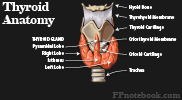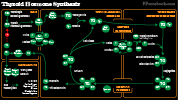Thyroid Anatomy, Thyroid Physiology, Thyroid, Thyroid Gland, Thyroid Hormone, Diiodotyrosine, Monoiodotyrosine, Thyroglobulin
- See Also
- Embryology
- Thyroid Gland develops from Tongue root (foramen cecum)
- Formed by 5th-6th week of development
- Anatomy
- Images
- Normal Adult Thyroid weighs 20-25g
- Components
- Two Lateral lobes
- Isthmus centrally connects the lobes
- Adjacent structures
- Recurrent laryngeal nerve
- Parathyroid Glands
- Physiology
- Images
- Stressors stimulate increased Thyroid function
- Puberty
- Pregnancy
- Physiologic stress
-
Hypothalamus
- Thyrotropin Releasing Hormone (TRH) released
- TRH passes down pituitary stalk to pituitary
- Anterior Pituitary
- Thyroid Stimulating Hormone (TSH) released
- TSH passes into circulation to Thyroid
- Thyroid
- Iodine is absorbed from circulation (increased by TSH)
- Thyroglobulin is produced, bound to Tyrosine molecules and stored within Thyroid follicles
- TSH stimulates synthesis of T4 and T3 from Tyrosine bound to Thyroglobulin
- Thyroxine or Tetraiodothyronine (T4) released into circulation
- Triiodthyronine (T3) is also 20-30% produced in the Thyroid (remainder is peripheral conversion of T4)
- Peripheral Tissues
- Triiodothyronine (T3) produced from T4 deiodination
- Circulation
- Only unbound Thyroid Hormones (Free T4 or T3) are metabolically active
- Thyroid Binding Globulin (TBG) binds T4 and T3
- T4 and T3 stimulate all metabolic processes
- T3 is several times more potent than T4
- Effects of Thyroid Hormone
- Triiodthyronine (T3) promotes DNA Transcription resulting in RNA Translation to enzymes and Protein synthesis
- Peripheral tissue oxygen utilization and basal metabolic rate increased
- Positive chronotropic and ionotropic cardiovascular effects, with secondary increased Cardiac Output
- Decreases Systemic Vascular Resistance via arteriole dilation
- When Thyroid Hormone is in excess (e.g. Thyroid Storm), high output Heart Failure may result
- Feedback Loop
- Increased T4 and T3 levels suppress TRH and TSH
- Pathophysiology
- See Hypothyroidism
- See Hyperthyroidism
- See Goiter
- See Thyroiditis
- See Thyroid Cancer
- References
- Mason, Herbert and Swadron in Herbert (2019) EM:Rap C3 3(11):1-10
- Goldberg (2014) Physiology, Medmaster, Miami, p. 136-8

